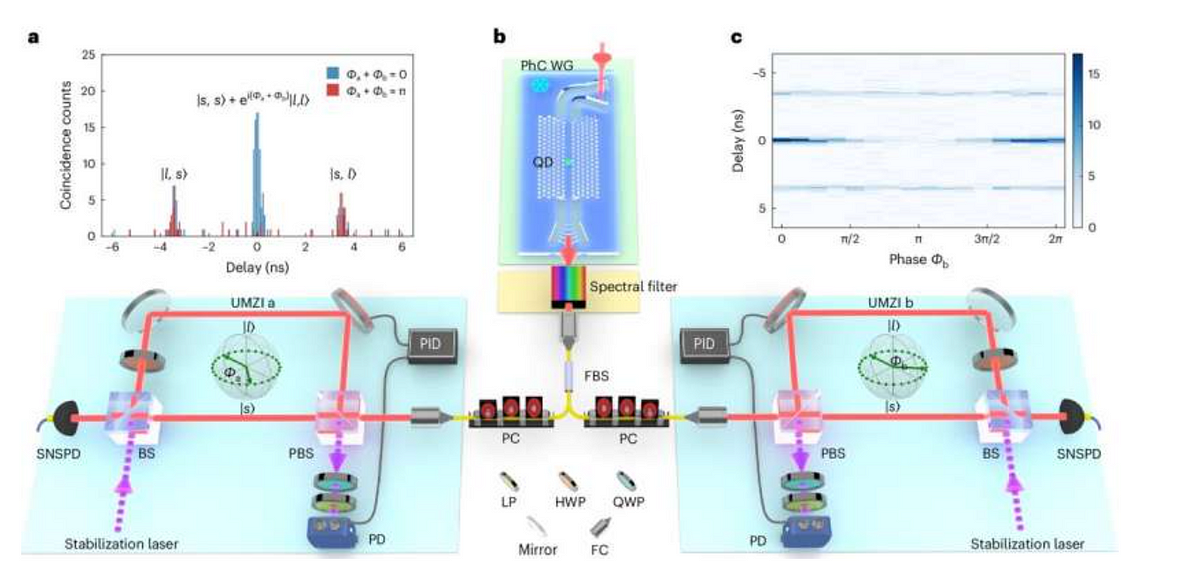A study in Nature Physics introduces a novel method for generating quantum entanglement using a quantum dot, which violates the Bell inequality. This ultra-low power method could pave the way for scalable and efficient quantum technologies. Quantum entanglement is essential for quantum computing, where qubits become correlated regardless of their distance. Measuring one qubit impacts the other, verified through the Bell inequality, a theorem that tests quantum mechanics by measuring entangled qubits.
Dr. Shikai Liu from The Niels Bohr Institute led the research, which focused on quantum dots and waveguides. Quantum dots are nanoscale structures that act like artificial atoms, trapping neutral excitons and exhibiting quantized energy states. These quantum dots, integrated into a chip, can emit single photons with high efficiency, which can become entangled under certain conditions. To improve efficiency and stability, the researchers coupled the quantum dot with a photonic crystal waveguide, enhancing light-matter interactions.
“During my Ph.D., I worked on generating entangled light sources using spontaneous parametric down-conversion (SPDC),” Liu told Phys.org during an interview. “However, the intrinsic weak nonlinearity of bulk crystals made it difficult to utilize pump photons fully. The giant nonlinearity at the single-photon level from quantum dots caught my attention and led me to this research.”
The team faced challenges in coupling the waveguide and quantum dot and had to deal with rapid dephasing caused by thermal vibrations in the crystal lattice. They minimized these interactions by cooling the chip to -269°C. With the setup in place, the researchers used unbalanced Mach-Zehnder interferometers to perform the Clauser-Horne-Shimony-Holt (CHSH) Bell inequality test, measuring Franson interference between emitted photons. This confirmed the quantum nature of the photon correlations.


Liu elaborated: “The Bell inequality distinguishes between classical and quantum correlations. Any local realistic theory must satisfy the condition: All measured correlations between particles must be less than or equal to two.”
“To improve the light-matter interaction, we fabricated a photonic-crystal waveguide that provides strong confinement for the quantum dot,” explained Liu. “This led to not only a high coupling efficiency of emitted light into the waveguide (greater than 90%) but also a Purcell enhancement of 16 by slowing down light in the nanostructure and increasing its interaction time with the quantum dot.”
“The observed S parameter of 2.67 ± 0.16 in our measurements is significantly above the locality bound of 2. This result confirmed the violation of the Bell inequality, thereby validating the energy-time entangled state generated via our method,” said Liu.
A notable feature of this method is its energy efficiency. Entanglement was generated at pump powers as low as 7.2 picowatts, about 1,000 times less than traditional single-photon sources. This ultra-low power operation, combined with on-chip integration, shows great promise for practical quantum technologies.
Liu sees several exciting directions for future research. “One avenue is exploring complex photonic quantum states and many-body interactions through inelastic scattering off multiple two-level emitters,” he suggested. “Additionally, further integration of our method into compatible photonic circuits will facilitate more functionalities with a small footprint, enhancing versatile photonic quantum applications involving computing, communication, and sensing.”


















